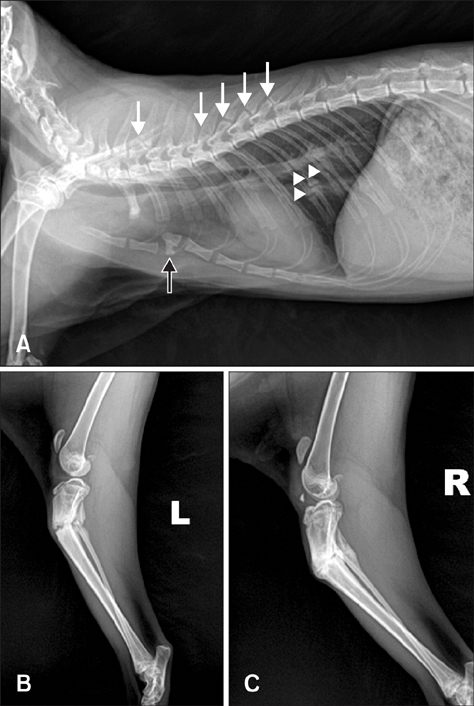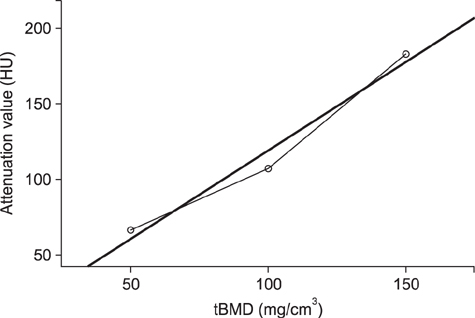J Vet Sci.
2017 Sep;18(3):415-417. 10.4142/jvs.2017.18.3.415.
Clinical application of quantitative computed tomography in osteogenesis imperfecta-suspected cat
- Affiliations
-
- 1Irion Animal Hospital, Seoul 06015, Korea.
- 2Ray Veterinary Medical Center, Seoul 06280, Korea.
- 3College of Veterinary Medicine and the Research Institute for Veterinary Science, Seoul National University, Seoul 08826, Korea. heeyoon@snu.ac.kr
- KMID: 2412460
- DOI: http://doi.org/10.4142/jvs.2017.18.3.415
Abstract
- One-year-old male Persian cat presented with multiple fractures and no known traumatic history. Marked decrease of bone radiopacity and thin cortices of all long bones were identified on radiography. Tentative diagnosis was osteogenesis imperfecta, a congenital disorder characterized by fragile bone. To determine bone mineral density (BMD), quantitative computed tomography (QCT) was performed. The QCT results revealed a mean trabecular BMD of vertebral bodies of 149.9 ± 86.5 mg/cm³. After bisphosphonate therapy, BMD of the same site increased significantly (218.5 ± 117.1 mg/cm³, p < 0.05). QCT was a useful diagnostic tool to diagnose osteopenia and quantify response to medical treatment.
MeSH Terms
-
Animals
Bone Density
Bone Density Conservation Agents/therapeutic use
Cat Diseases/*diagnostic imaging/pathology
Cats
Diphosphonates/therapeutic use
Male
Osteogenesis Imperfecta/diagnostic imaging/drug therapy/pathology/*veterinary
Radiography/veterinary
Tomography, X-Ray Computed/veterinary
Treatment Outcome
Bone Density Conservation Agents
Diphosphonates
Figure
Reference
-
1. Arthur DG, Thompson KG, Swarbrick P. Lethal osteogenesis imperfecta and skin fragility in newborn New Zealand Romney lambs. N Z Vet J. 1992; 40:112–116.
Article2. Burnei G, Vlad C, Georgescu I, Gavriliu TS, Dan D. Osteogenesis imperfecta: diagnosis and treatment. J Am Acad Orthop Surg. 2008; 16:356–366.
Article3. Cann CE. Quantitative CT for determination of bone mineral density: a review. Radiology. 1988; 166:509–522.
Article4. Cheon H, Choi W, Lee Y, Lee D, Kim J, Kang JH, Na K, Chang J, Chang D. Assessment of trabecular bone mineral density using quantitative computed tomography in normal cats. J Vet Med Sci. 2012; 74:1461–1467.
Article5. Dimeglio LA, Ford L, McClintock C, Peacock M. A comparison of oral and intravenous bisphosphonate therapy for children with osteogenesis imperfecta. J Pediatr Endocrinol Metab. 2005; 18:43–54.
Article6. Horvarth SA, Francesetti FL, Riveros SV. [Treatment of imperfect osteogenesis in a tiger (Panthera tigris)]. Av Cienc Vet. 1986; 1:49–51. Spanish.7. Jensen PT, Rasmussen PG, Basse A. Congenital osteogenesis imperfecta in Charollais cattle. Nord Vet Med. 1976; 28:304–308.8. Lauten SD, Cox NR, Baker GH, Painter DJ, Morrison NE, Baker HJ. Body composition of growing and adult cats as measured by use of dual energy X-ray absorptiometry. Comp Med. 2000; 50:175–183.9. Plotkin H, Rauch F, Bishop NJ, Montpetit K, Ruck-Gibis J, Travers R, Glorieux FH. Pamidronate treatment of severe osteogenesis imperfecta in children under 3 years of age. J Clin Endocrinol Metab. 2000; 85:1846–1850.
Article10. Rauch F, Glorieux FH. Osteogenesis imperfecta. Lancet. 2004; 363:1377–1385.
Article11. Sartoris DJ, Resnick D. Dual-energy radiographic absorptiometry for bone densitometry: current status and perspective. AJR Am J Roentgenol. 1989; 152:241–246.
Article12. Scott PP, Mckusick VA, Mckusick AB. The nature of osteogenesis imperfecta in cats. Evidence that the disorder is primarily nutritional, not genetic, and therefore not analogous to the disease in man. J Bone Joint Surg Am. 1963; 45:125–134.13. Seeliger F, Leeb T, Peters M, Brügmann M, Fehr M, Hewicker-Trautwein M. Osteogenesis imperfecta in two litters of dachshunds. Vet Pathol. 2003; 40:530–539.
Article




